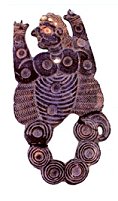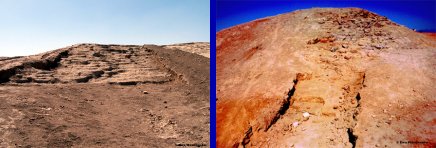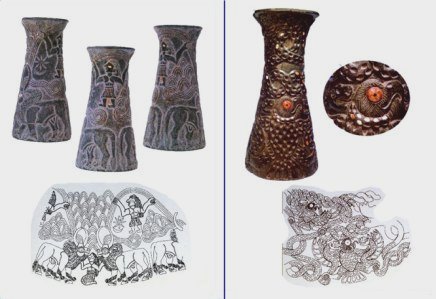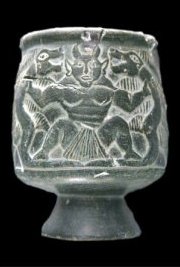Jiroft: A Lost
Kingdom of …?
 .
.
 |
.... |
Is
this an ancient game board missing its instructions as Dr. Madzjizadeh
suggests? Whether it is or not, the 2001 discovery of Jiroft civilization
has become a big game between looters and archaeologists. The scholarly
world lost at the beginning – between 2000 to 100,000 Jiroft objects left
Iran illegally …

|

Jiroft,
a small city in the southeastern province of Iran, Kerman, has become a
center of archaeological interest after the 2001 flash flood revealed one
of the “forgotten and lost” civilizations of the ancient world. As the
story goes, “an old object…was floating on the surface of water” and was
retrieved by a peasant from a nearby village.
Next
day, impoverished by years of drought villagers swarmed along the banks
of the Halil River in search of 5000 years old antiquities. They carefully
divided the area into six square meters lots so each family would have
a fair chance to strike it rich. And they did. For the next three years
archaeologists could only watch hopelessly thousands of looters digging
up objects of incomparable beauty of the civilization which once must have
been equal to Mesopotamia and Egypt.
Wherever
are looters, there are also dealers who smuggle ancient objects out of
the country. Thousands of objects, mainly carved and inlaid steatite vases,
appeared in Europe and elsewhere with a generic description of the “Middle
Eastern” or “Kerman” vases. The demand for these vases has been so high
that a new industry has been created: production of fake Jiroft-vases easily
sold to whomever wants to have a piece of ancient history.
Finally,
under the leadership of Dr. Yousef Madjidzadeh, a team of international
archaeologists began excavations in 2003. While his discoveries has not
produced such spectacular vases and statuettes as those delivered by villagers,
he was able to estimate that over 700 sites is possibly located in the
area of about 400 square km. Focusing on two hills of Konar Sandal, he
has been able to identify a construction which he classifies as a ziqqurat
(a temple-tower of Mesopotamian origin) and a citadel, both dated by him
to the 3rd millennium B.C. In addition, six large cemeteries, a large industrial
center near Anbaraba, and numerous domestic structures have been discovered
in the surveyed area.
Among
artifacts 25 seals were discovered and the first undisputable evidence
of writing: a clay brick with an Elamitic inscription.
This
presentation introduces an audience to Jiroft, its findings, and its importance
with regard to other well-researched cradles of civilizations of the same
time period such as Sumer, Egypt, Elam and Indus Valley. Who were these
people? What mythical scenes do these carvings represent? What language
did they speak? Whether this is a lost kingdom of Aratta as Dr. Madzjizadeh
believes or not, Jiroft is definitely the Lost Paradise for archaeologists
and anyone who has a passion for ancient history.


The
area of Jiroft cemeteries looks like a big piece of Swiss cheese: full
of illegally “excavated” holes with in-between tunnels to escape in case
a lonely guard might pass by. It is estimated that within 9 months since
the first object was discovered in 2001 10,000 holes were dug in this looting
Eldorado.

Is
Konar Sandal A a ziggurat (a temple-tower commonly believed to be of the
Sumerian origin)? Dr. Madzjizadeh thinks so dating this structure to ca.
2300 B.C.

While
opinions are divided among scholars whether the ziggurat like structure
in Jiroft is a true ziggurat with such an early dating, others are getting
busy to proclaim the Jiroft civilization to be number one in the whole
world. Just see this picture comparing measurements of the Great Pyramid
of Cheops (Khufu) to the Jiroft structure. At this moment, this seems to
be rather a wishful thinking.


A
fragment of a clay brick with an Elamitic writing has been discovered during
2005 expedition. This is the only undisputable example of writing discovered
in Jiroft as of today. Dr. Madzjizadeh reported a clay impression with
possible writing previously but this one was not available for verification.
There is at least one more inscription in an unknown script associated
with a Jiroft statuette but the artifact itself might be a forgery.

 |
.... |
Thousands
of pottery pieces have been smashed by local villagers searching for much
more attractive and profitable steatite objects. This and other vases have
been recovered by archaeologists. |


These
beautiful steatite vases represent amazing world of ancient myths, realities,
and dreams. Many of them were inlaid with precious and semi-precious stones
emphasizing the importance and fascination with both the sacred and the
profane.

 |
.... |
Shahname
(“The Book of Kings”) written by Ferdausi in ca. 1000, refers to many demons
who were presented as people with different religious beliefs than Zoroastrians.
They refused to accept changes brought by a new civilization. They symbolized
violence but also simplicity. Is it possible that thousands of years before
Ferdausi, the civilized people of Jiroft considered others around them
to be demons too? |
 |

